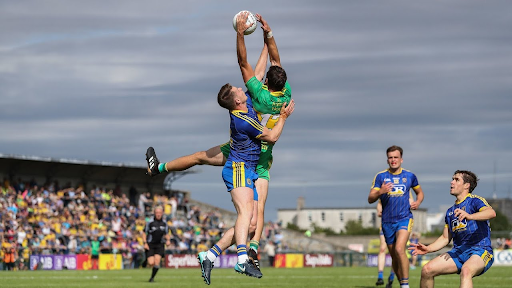Most countries in the western world have their own unique sports that never caught on anywhere else, often (but not always) a derivative of rugby like the aptly named games of American, Australian Rules and Canadian football; the similarly named Gaelic football occupies the same class, albeit in the family of association football.
The American, Australian, and Canadian variants of the sport remain unique to their home countries because of their peculiarities—whether it’s the neverending commercial breaks in American football that put off foreign viewers, or the obscure rules of all three of the sports that make them a pain for new spectators to pick up.
With Gaelic football, though, that uniqueness is a source of national pride, a reminder of the Emerald Isle’s rich history and culture and a tradition to be preserved and passed on, much like Irish Gaelic. The sport is one of the Gaelic games, athletic competitions that surpass even association football and rugby in popularity in Ireland: here’s a look at what they are and what makes them stand out. Unlike other sports leagues around the world, games like Gaelic football remain strictly amateur, but that increased accessibility doesn’t take away from the skillful level of play.
Gaelic Football
I said earlier that Gaelic football favors its relatives on the pitch over those on the gridiron. That’s largely true, with one crucial difference. While association football players are forbidden from making contact with the ball with any part of their arms below the shoulders, Gaelic football players are free to move around by carrying it, bouncing it, hand-passing it to another player by striking the ball (as opposed to an outright throw, which is prohibited) or soloing, kicking the ball into their own hands in a move akin to juggling a football.
Players can’t take more than five steps while carrying the ball without releasing it via a hand-pass, dropping it to the ground, or deploying a bounce or solo, giving the sport a unique flair reminiscent of dribbling a basketball. Tackling the ball is allowed, so there’s significantly more contact than you’d see in an association match: rugby tackling opposing players remains forbidden, though.
Goals are worth three points in Gaelic football, scored in the same manner as their association football counterparts, but players can also score single points by kicking the ball over the crossbar and between a pair of uprights, similar to a field goal in American football.
That makes for some frenetic action whenever the ball gets within scoring range, as it’s much easier to score than in association football: with 15 players on either side of a modified, enlarged rugby pitch, there’s plenty of room for athletes to work with, and high scoring action as a result.The most popular sport in Ireland, Ireland Online Casinos have plenty of betting opportunities for those who want to wager on Gaelic football, or any of the other Gaelic games.
Handball
The other major sport of the Gaelic games, Gaelic handball is played on an indoor court, with players attempting to bounce a ball off the wall in such a manner that the opposing players are unable to return the favor. Players can take part in singles and doubles matches, and as with Gaelic football, variety is the name of the game.
While most courts feature four walls, variants with three walls and one wall are available, making it possible to take part in pickup games with ease if a playing surface isn’t readily available. While a hardball variant of the game exists, most handball athletes prefer to play with a softer ball, preserving the hands they strike with for future games.
Women’s Sports and Other Games
Women’s versions of Gaelic football and handball exist in Ireland, while the women’s-only game of camogie substitutes for the men’s game of hurling.
Hurling and camogie play in a similar fashion to lacrosse, with players using an ash stick to hit the ball, called a sliotar, around the field in an attempt to score goals. Unlike lacrosse, the sticks don’t have a net, which makes for a different style of play. The rules of hurling and camogie are nearly identical, although camogie players can score goals via hand-pass, a move forbidden in hurling.
Other games include rounders, which actually dates back to sixteenth-century England but caught on in a big way on the other side of the Irish Sea: the Irish took the game and ran with it, becoming the first to codify formal rules for the game in 1884.
For the uninitiated, it plays in a similar fashion to softball, but there are no balls and strikes. Batters receive just one offering to swing at, and must attempt to round the bases even if they miss. This makes for a fast paced game that’s perfect for school children, especially given the fact that the game lasts just two nine-out innings: perfect for squeezing in during recess.
While co-ed options are pretty easy to pull off in the schoolyard style, rounders is traditionally thought of as a girls sport.
Help keep news FREE for our readers
Supporting your local community newspaper/online news outlet is crucial now more than ever. If you believe in independent journalism, then consider making a valuable contribution by making a one-time or monthly donation. We operate in rural areas where providing unbiased news can be challenging. Read More About Supporting The West Wales Chronicle






















